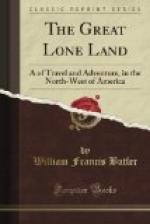Thus, through the whole course of the Winnipeg, from
lake to lake, I could glean no tale or tidings of
the great Ogima or of his myriad warriors. It
was quite dark when we reached, on the evening of
the 30th July, the northern edge of the Lake of the
Woods and paddled across its placid waters to the Hudson
Bay Company’s post at the Rat Portage.
An arrival of a canoe with six strangers is no ordinary
event at one of these remote posts which the great
fur company have built at long intervals over their
immense territory. Out came the denizens of a
few Indian lodges, out came the people of the fort
and the clerk in charge of it. My first question
was about the Expedition, but here, as elsewhere,
no tidings had been heard of it. Other tidings
were however forthcoming which struck terror into
the heart of Hope. Suspicious canoes had been
seen for-some days past amongst the many islands of
the lake; strange men had come to the fort at night,
and strange fires had been seen on the islands-the
French were out on the lake. The officer in charge
of the post was absent at the time of my visit, but
I had met him at Fort Alexander, and he had anticipated
my wants in a letter which I myself carried to his
son. I now determined to strain every effort
to cross with rapidity the Lake of the Woods and ascend
the Rainy River to the next post of the Company, Fort
Francis, distant from Rat Portage about 1400 miles,
for there I felt sure that I must learn tidings of
the Expedition and bring my long solitary journey
to a close. But the Lake of the Woods is an immense
sheet of water lying 1000 feet above the sea level,
and subject to violent gales which lash its bosom
into angry billows. To be detained upon some island,
storm-bound amidst the lake, %would never have answered,
so I ordered a large keeled boat to be got ready by
midday it only required a few trifling repairs of
sail and oars, but a great feast had to be gone through
in which my pemmican and flour were destined to play
a very prominent part. As the word pemmican is
one which may figure frequently in these pages, a
few words explanatory of it may be useful. Pemmican,
the favourite food of the Indian and the half-breed
voyageur, can be made from the flesh of any animal,
but it is nearly altogether composed of buffalo meat;
the meat is first cut into slices, then dried either
by fire or in the sun, and then pounded or beaten
out into a thick flaky substance; in this state it
is put into a large bag made from the hide of the
animal, the dry pulp being soldered down into a hard
solid mass by melted fat being poured over it-the
quantity of fat is nearly half the total weight, forty
pounds of fat going to fifty pounds of “beat
meat;” the best pemmican generally has added
to it ten pounds of berries and sugar, the whole composition
forming the most solid description of food that man
can make. If any person should feel inclined to
ask, “What does pemmicau taste like?”
I can only reply, “Like pemmican,” there




